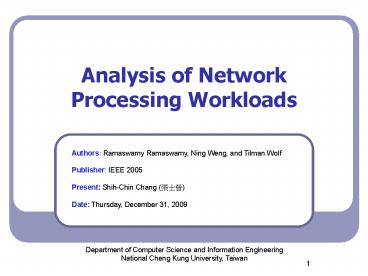Analysis of Network Processing Workloads - PowerPoint PPT Presentation
1 / 24
Title:
Analysis of Network Processing Workloads
Description:
Department of Computer Science and Information Engineering. National Cheng Kung University, Taiwan ... The key point about this system design: ... – PowerPoint PPT presentation
Number of Views:85
Avg rating:3.0/5.0
Title: Analysis of Network Processing Workloads
1
Analysis of Network Processing Workloads
Authors Ramaswamy Ramaswamy, Ning Weng, and
Tilman Wolf Publisher IEEE 2005 Present
Shih-Chin Chang (???) Date Thursday, December
31, 2009
Department of Computer Science and Information
Engineering National Cheng Kung University,
Taiwan
2
Outline
- Introduction
- PacketBench
- PacketBench System
- PacketBench API
- PacketBench Prototype
- Application Workload
- Network Processing Applications
- Network Traces and Routing Tables
- Results
- Average Statistics
- Variation across Packets
- Individual Packet Analysis
3
Introduction
4
Introduction (cont.)
- Compared to other network processing simulators
and benchmarks, PacketBench - First, be programmed easily
- Second, allow applications to operate on actual
packets in the same fashion as it is done inside
the NP. - Third, be able to hide the overhead for packet
preprocessing in the PacketBench framework. - PacketBench can be used in
- Application Optimization
- Allocation of Processing Tasks
- Developing Novel NP Architectures
- Understanding the Dynamics of Network Processing
5
Outline
- Introduction
- PacketBench
- PacketBench System
- PacketBench API
- PacketBench Prototype
- Application Workload
- Network Processing Applications
- Network Traces and Routing Tables
- Results
- Average Statistics
- Variation across Packets
- Individual Packet Analysis
6
PacketBench
PacketBench Framework
7
PacketBench System
- The key point about this system design
- The application and the framework can be clearly
distinguished even though both components need
to be compiled into a single executable in order
to be simulated. - This is done by analyzing the instruction
addresses and sequence of API calls.
8
PacketBench System (cont.)
- PacketBench Framework
- To provide functions that are necessary to read
and write packets, and manage memory. - PacketBench API
- To distinguish between PacketBench and
application operations during simulation. - Network Processing Application
- To implement the actual processing of the
packets. - Processor Simulator
- To get instruction-level workload statistics.
9
PacketBench API
- To define how applications can receive, send, or
drop packets. - void init()
- This function is implemented by the application
and called by the framework before any packets
are processed. - void (process_packet_function)(packet )
- This function is the packet handler that is
implemented by the application. - void write_packet_to_file(packet , int)
- This function is implemented by the framework and
called by the application when processing is
complete.
10
PacketBench Prototype
- Use the ARM target of the SimpleScalar simulator
to analyze the applications. - The ARM architecture is very similar to the
architecture of the core processor and the
microengines found in the Intel IXP 2400 network
processor. - The tools were setup to work on an Intel x86
workstation running RedHat Linux 9.0. - PacketBench supports packet traces in the tcpdump
format and the Time Sequenced Header (TSH) format
from NLANR.
11
Outline
- Introduction
- PacketBench
- PacketBench System
- PacketBench API
- PacketBench Prototype
- Application Workload
- Network Processing Applications
- Network Traces and Routing Tables
- Results
- Average Statistics
- Variation across Packets
- Individual Packet Analysis
12
Application Workload
- Network Processing Applications
- IPv4-radix
- IPv4-trie
- Flow Classification
- TSA (Top-hashed Subtree-replicated Anonymization)
- Network Traces and Routing Tables
13
Outline
- Introduction
- PacketBench
- PacketBench System
- PacketBench API
- PacketBench Prototype
- Application Workload
- Network Processing Applications
- Network Traces and Routing Tables
- Results
- Average Statistics
- Variation across Packets
- Individual Packet Analysis
14
Results
- Three classes of results that can be derived
- Microarchitectural Results
- Network Processing Results
- Per-Packet Analysis
- These statistics are divided into three
categories - Averaged Statistics
- Variation across Packets
- Individual Packet Analysis
- Processing complexity the average number of
instructions executed per packet. - The memory accesses and coverage statistics can
- Distinguish between instruction and data memory.
- Separate data memory into packet data and program
data.
15
Average Statistics
- Processing Complexity
The overhead of maintaining and traversing the
radix tree.
Take the same amount of instructions.
16
Average Statistics (cont.)
- Memory Accesses
- Accesses to packet memory (e.g. the packet
header, the payload) - Accesses to non-packet memory (e.g. routing
tables, flow tables) - This analysis was performed for the first 10,000
packets of each trace.
17
Average Statistics (cont.)
- Memory Coverage
- By SimpleScalar
- This analysis was performed on the first 1,000
packets of the MRA trace.
Due to large data structures.
18
Variation across Packets
- Processing Complexity
The first 500 packets of the MRA trace.
The first 100,000 packets of the COS trace.
19
Variation across Packets (cont.)
- Memory Accesses
20
Individual Packet Analysis
- Instruction Pattern
21
Individual Packet Analysis (cont.)
- Unique Instructions
The first 100,000 packets of the COS trace.
22
Individual Packet Analysis (cont.)
- Basic Block Access Frequency
23
Individual Packet Analysis (cont.)
- Basic Block Coverage
24
Individual Packet Analysis (cont.)
- Memory Access Sequence































